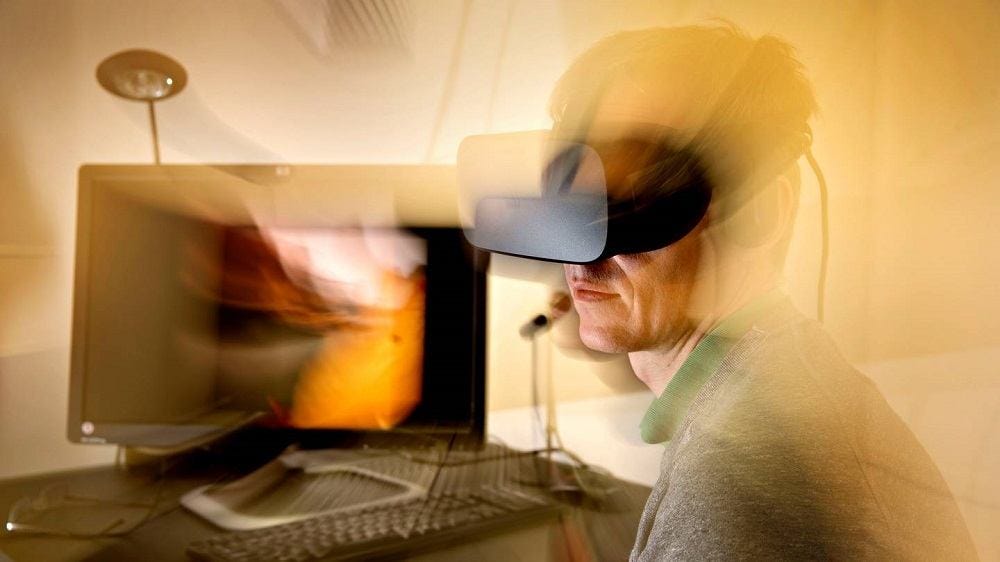Virtual Reality Headsets Should Be Banned
Click to read the full story: Virtual Reality Headsets Should Be Banned

Virtual Reality headsets such as the Oculus Rift, HTC Vive and Samsung Gear VR should be banned according to a military flight simulator expert named Steve Baker. According to him, these devices aren’t healthy for the eyes and disorienting to the brain. Anyone who has subjected themselves to a simulated or virtual environment should take a breather for several hours to a whole day before doing activities such as flying or driving.
It’s like when one ingests alcoholic drinks. If this were true, then consumers have a big problem. 2016 is the year of VR and VR devices will be coming in by the thousands especially in the upcoming holidays. With such a quickly evolving industry with high potential for profit, banning these devices could be highly unlikely. It’s all fun and games until some pilot, fresh from his virtual quest in the land of Middle Earth crashes into some transmission tower.
There are some cases where people suffer from nausea when watching 3D movies or after testing VR equipment. These could also be the same people who can’t handle a long bus ride sitting next to the window watching everything outside that moves. People have varying degrees of tolerance to motion sickness caused by conflicting sensory input. When watching an ordinary 2D movie, the eyes are converged and focused on a fixed area several meters away, which is the movie screen. But with 3D, amazing as it looks, can confuse the senses with plenty happening on screen.
In a scene from Star Trek: Into Darkness when Captain Kirk is being chased by the Nibiru natives, the trees seem to be really moving away as he runs and the spears appear as if they’re hitting or going past the viewer. While many can appreciate 3D magic, some people can’t. They take off their glasses, wipe their eyes for a bit, put them back and after a few minutes take them off again and hurl a gooey combination of pre-digested popcorn, hotdogs and soda on the cinema floor. It’s the same case with virtual reality headsets as per Mr. Baker.
“I’ve been working with helmet mounted displays in military flight simulation for several decades – I am an expert in the field… IMHO – these devices should be banned – but that may not be necessary because after the first wave of early adopters I think it’ll go the way of 3D televisions. But that’s just my opinion. Let me explain why.
Everyone thinks these things are new and revolutionary…but they really aren’t. All that’s happened is that they dropped in price from $80,000 to $500…and many corners have been cut along the way. There are several claims that the nausea problem has either been fixed, or will soon be fixed, or that application design can be used to work around the problem.
The claims that it’s been fixed are based on the theory that the nausea is caused by latency/lag in the system, or by low-resolution displays or by inaccurate head motion tracking…all of which can (and are) being fixed by obvious improvements to the system. Sadly, the $80,000 googles we made for the US military had less latency, higher resolution displays, and more accurate head tracking than any of the current round of civilian VR goggles…and they definitely made people sick – so this seems unlikely.
The problem is that the people who make those claims are either ignorant (or are deliberately ignoring) the evidence collected over 20 years of flight simulation experience with VR goggles (only we called them ‘Helmet Mounted Displays’ – HMD’s – and what we did was called ‘simulation’ and not ‘virtual reality’). Worse still, there is strong research evidence that the harm they cause extends for as much as 8 hours AFTER you stop using the goggles. Considerable disorientation after prolonged exposure to VR. The US military recommends that users avoid flying or driving for up to 24 hours…”
— Steve Baker, through Quora
Mr. Baker further explains the VR issue in terms of depth perception where in the eyes are manipulated by the headset into seeing two different image depths (left and right eye displays) into one image. In doing so, there is continuous tension on the eye’s inter-ocular muscles. The eyes are doing double duty getting focus and convergence. Focus and convergence don’t always agree in VR and depending on a person’s tolerance, the brain is trying to decide whether the projected image is a hallucination or not.
We know for a fact that the image isn’t real and we see it for what it is but the inner workings of the brain says it’s an image we’re not actually seeing. Once the brain decides it’s a hallucination, the rest of the body thinks it has ingested something poisonous and the rest is biology.
He explains further in terms of momentum wherein the body thinks it’s moving when it’s not. It’s simply the user pressing up on the D-pad or analog stick. Now imagine a headset or an app with bad latency. The image turns late when the head’s already there. It’s a very dizzying experience which Google Daydream says it’s fixing.
It takes a lot of power to do so which is why only newer phones certified for it can run it. As per Mr. Baker, no amount of current tech can solve the latency issue as the stuff he’s worked on using million-dollar equipment has less latency but people still get queasy.

Gamers would argue, especially those who get more and more into their devices that they can withstand nausea. Anyone determined to save their princess or defeat the evil empire probably could. But the US Navy apparently conducted a study that the disorientation even at a level unnoticed by hardcore gamers can have extended effects for up to two days.
As mentioned, the Navy doesn’t recommend anyone driving a vehicle or flying a plane for 24 hours after being in a simulator, which is what VR headsets are. If everything Mr. Baker and the US Navy says is true, then VR users should keep off the roads for a minimum of 6 hours after use.
Think you can handle it? No problem. Hopefully you don’t have to make a trip somewhere which requires you to drive or your boss calls you to work while you’re busy slaying an orc pretending it’s your boss. Microsoft’s mixed-reality initiative suddenly seems like a good idea.
The post Virtual Reality Headsets Should Be Banned appeared first on Movie TV Tech Geeks News By: Marius Manuella
